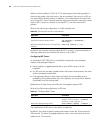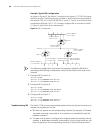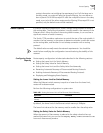
IP Routing Policy 99
IP Routing Policy When a router distributes or receives routing information, it needs to implement
policies to filter the routing information so it can receive or distribute the routing
information that meets only the specified condition. A routing protocol such as RIP
may need to import routing information discovered by other protocols to enrich its
routing knowledge. While importing the routing information, it must import only
the information that meets its conditions.
To implement the routing policy, you must define a set of rules by specifying the
characteristics of the routing information to be filtered. You can set the rules
based on such attributes as destination address and source address of the
information. The rules can be set in advance and then used in the routing policy to
advertise, receive, and import the route information.
Configuring IP Routing Policy is described in the following sections:
■ Routing Information Filters
■ Configuring an IP Routing Policy
■ Troubleshooting Routing Policies
■ Configuring Route Capacity
Routing Information
Filters
The Switch 7750 supports four kinds of filters, route-policy, acl, ip-prefix, and
community-list. The following sections introduce these filters:
■ Route Policy
■ ACL
■ IP Prefix
Route Policy
A route map is used for matching some attributes with given routing information
and the attributes of the information will be set if the conditions are satisfied.
A route map can include multiple nodes. Each node is a unit for match testing,
and the nodes are matched in a sequence-number-based order. Each node
includes a set of if-match and apply clauses. The if-match clauses define the
matching rules and the matching objects are attributes of routing information. The
comparison of if-match clauses for a node uses a series of Boolean and
statements. As a result, a match is found if all the matching conditions specified by
the if-match clauses are satisfied. The apply clause specifies the actions that are
performed after the node match test concerning the attribute settings of the route
information.
The comparison of different nodes in a route policy uses a Boolean or statement.
The system examines the nodes in the route policy in sequence. Once the route is
permitted by a single node in the route policy, the route passes the matching test
of the route policy without attempting the test of the next node.
ACL
The access control list (ACL) used by the route policy can be divided into three
types: advanced ACL, basic ACL, and Layer-2 ACL.


















